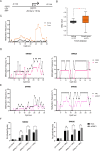Epigenetic regulation of intestinal peptide transporter PEPT1 as a potential strategy for colorectal cancer sensitization
- PMID: 34031358
- PMCID: PMC8144210
- DOI: 10.1038/s41419-021-03814-5
Epigenetic regulation of intestinal peptide transporter PEPT1 as a potential strategy for colorectal cancer sensitization
Abstract
Human intestinal peptide transporter PEPT1 is commonly repressed in human colorectal cancer (CRC), yet its relationship with sensitivity to the common CRC treatment ubenimex has not previously been elucidated. In this study, we confirmed PEPT1 suppression in CRC using real-time quantitative polymerase chain reaction and western blotting and then investigated the underlying epigenetic pathways involved using bisulfite sequencing, chromatin immunoprecipitation, siRNA knockdown, and reporter gene assays. We found that PEPT1 transcriptional repression was due to both DNMT1-mediated DNA methylation of the proximal promoter region and HDAC1-mediated histone deacetylation, which blocked P300-mediated H3K18/27Ac at the PEPT1 distal promoter. Finally, the effects of the epigenetic activation of PEPT1 on the CRC response to ubenimex were evaluated using sequential combination therapy of decitabine and ubenimex both in vitro and in xenografts. In conclusion, epigenetic silencing of PEPT1 due to increased DNMT1 and HDAC1 expression plays a vital role in the poor response of CRC to ubenimex.
Conflict of interest statement
The authors declare no competing interests.
Figures







Similar articles
-
Preclinical activity of the rational combination of selumetinib (AZD6244) in combination with vorinostat in KRAS-mutant colorectal cancer models.Clin Cancer Res. 2012 Feb 15;18(4):1051-62. doi: 10.1158/1078-0432.CCR-11-1507. Epub 2011 Dec 15. Clin Cancer Res. 2012. PMID: 22173548 Free PMC article.
-
Histone deacetylase inhibitors potentiate photodynamic therapy in colon cancer cells marked by chromatin-mediated epigenetic regulation of CDKN1A.Clin Epigenetics. 2017 Jun 8;9:62. doi: 10.1186/s13148-017-0359-x. eCollection 2017. Clin Epigenetics. 2017. PMID: 28603560 Free PMC article.
-
Combined inhibition of DNA methylation and histone acetylation enhances gene re-expression and drug sensitivity in vivo.Br J Cancer. 2009 Mar 10;100(5):758-63. doi: 10.1038/sj.bjc.6604932. Br J Cancer. 2009. PMID: 19259094 Free PMC article.
-
Breaking the barrier: Epigenetic strategies to combat platinum resistance in colorectal cancer.Drug Resist Updat. 2024 Nov;77:101152. doi: 10.1016/j.drup.2024.101152. Epub 2024 Sep 28. Drug Resist Updat. 2024. PMID: 39369466 Review.
-
Histone Deacetylase Modifications by Probiotics in Colorectal Cancer.J Gastrointest Cancer. 2020 Sep;51(3):754-764. doi: 10.1007/s12029-019-00338-2. J Gastrointest Cancer. 2020. PMID: 31808058 Review.
Cited by
-
Epigenetic regulation of RARB overcomes the radio-resistance of colorectal carcinoma cells via cancer stem cells.J Radiat Res. 2023 Jan 20;64(1):11-23. doi: 10.1093/jrr/rrac060. J Radiat Res. 2023. PMID: 36214504 Free PMC article.
-
Peptide Transporter 1-Mediated Dipeptide Transport Promotes Hepatocellular Carcinoma Metastasis by Activating MAP4K4/G3BP2 Signaling Axis.Adv Sci (Weinh). 2024 Jun;11(24):e2306671. doi: 10.1002/advs.202306671. Epub 2024 Apr 19. Adv Sci (Weinh). 2024. PMID: 38639383 Free PMC article.
-
Combined inhibition of histone deacetylase and cytidine deaminase improves epigenetic potency of decitabine in colorectal adenocarcinomas.Clin Epigenetics. 2023 May 19;15(1):89. doi: 10.1186/s13148-023-01500-1. Clin Epigenetics. 2023. PMID: 37208732 Free PMC article.
-
SLC38A3 Promotes the Proliferation and Migration of Tumor Cells and Predicts Poor Prognosis in Colorectal Cancer.ACS Omega. 2024 May 2;9(19):21116-21126. doi: 10.1021/acsomega.4c00901. eCollection 2024 May 14. ACS Omega. 2024. PMID: 38764627 Free PMC article.
-
Active Enhancer Assessment by H3K27ac ChIP-seq Reveals Claudin-1 as a Biomarker for Radiation Resistance in Colorectal Cancer.Dose Response. 2021 Dec 8;19(4):15593258211058981. doi: 10.1177/15593258211058981. eCollection 2021 Oct-Dec. Dose Response. 2021. PMID: 34987334 Free PMC article.
References
-
- Sung, H. et al. Global cancer statistics 2020: GLOBOCAN estimates of incidence and mortality worldwide for 36 cancers in 185 countries. Cancer J. Clin. caac.21660 10.3322/caac.21660 (2021). - PubMed
Publication types
MeSH terms
Substances
Grants and funding
LinkOut - more resources
Full Text Sources
Other Literature Sources
Medical
Molecular Biology Databases
Miscellaneous

